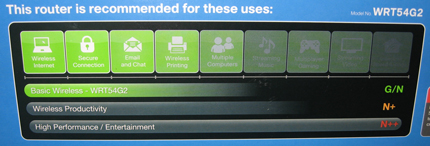I was in Best Buy the other day browsing some wi-fi access points and came across the WRT54G2 which seemed to suit my purposes. On the back of the box I encountered this interesting piece of marketing material:
Now seriously, what the hell? They’re using a fading scale to indicate the uses? So I suppose “Multiple Computers” is vaguely recommended? And “Streaming Music” seems to be slightly recommended? I suppose the usage icon on the far right is downright not recommended, but can’t we just get an honest do or don’t from the usage guide?
And then the marketing team seems to have their own rating system which is not explained anywhere and is completely unhelpful. Ok, so “High Performance” is rated N++! Are you kidding me? What the hell is a “N”, and what does a plus sign indicate? What would “N–” mean?
The back of the box should be a case study in a marketing class on what not to do!
A quick tech tip… there are actually TWO WRT54G2 models floating around on shelves. DO NOT buy the one that has this silly thing on the back of the box, it actually has less onboard memory than the other model. But they both cost the same.

 I was running into ALL kinds of problems with WMP on Vista (64, but I hear 32 is bad also) where it was not ripping my CDs into MP3s, getting errors when trying to even play my CDs, and generally confusing the hell out of me. It was NOT a codec problem, everything was normal on my system. In fact, it would play about 30 seconds of a song and then throw an error.
I was running into ALL kinds of problems with WMP on Vista (64, but I hear 32 is bad also) where it was not ripping my CDs into MP3s, getting errors when trying to even play my CDs, and generally confusing the hell out of me. It was NOT a codec problem, everything was normal on my system. In fact, it would play about 30 seconds of a song and then throw an error.